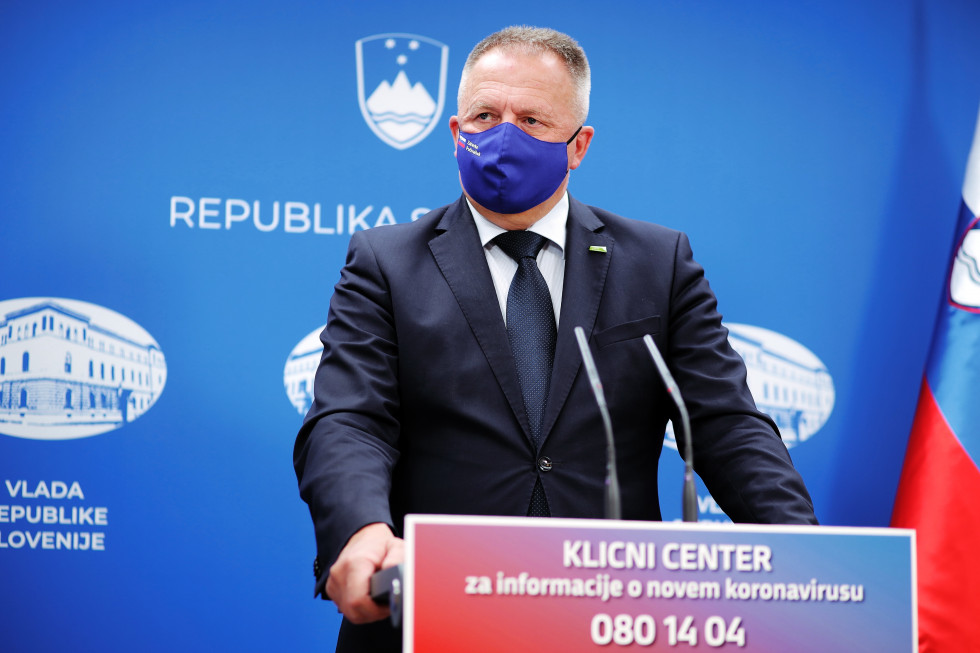Dr Tatjana Lejko Zupanc: Ljubljana University Medical Centre has enough space and staff so that it will not be necessary to decide who receives treatment
5891 tests were conducted on Tuesday, with 1503 positive cases, or 25.51 percent. 333 patients have been hospitalised, with 55 in intensive care. There were eight deaths. The 14-day notification rate per 100,000 inhabitants increased to 423.
Ljubljana University Medical Centre is expanding its capacities in order to provide a total of 170 ordinary beds and 50 beds in intensive care, said Dr Lejko Zupanc. At the moment there are 92 adults and 5 children hospitalised at all of its locations, and 21 patients in intensive care units, the majority of whom are attached to ventilators.
Ljubljana University Medical Centre has requested the cooperation of younger retired former employees, and volunteers, students in the final years of medical school and other healthcare disciplines, specialists, trainees and interns have also been enlisted to work at the hospital. They will be assisted by other doctors who will not be working in their professional fields.
Dr Lejko Zupanc decisively rejected Dušan Keber’s assertion in the newspaper Delo that the time is approaching where doctors will have to decide whom to keep alive.
The head of the Infectious Diseases Clinic advised individuals who are at high risk of contact with persons who are confirmed positive to self-quarantine for at least 7 days. A high-risk contact is defined as a case where neither of the persons was wearing a mask, and remained in contact for 15 minutes.
Yesterday, the government adopted an amendment to the ordinance regarding the limit to the sales of goods and services, said Minister Zdravko Počivalšek.
This means that in addition to discos and nightclubs, cinemas and cultural institutions will also be prohibited from providing services. Exceptions include galleries, museums, archives and libraries, however with the restriction of 1 person per 20 m2.
Food service activities involving food and drink preparation and service is prohibited in red regions.
Food service facilities in orange regions can operate from 6 a.m. to 9 p.m., but only at tables (seated service) and while maintaining a distance of at least 1.5 m between people, except for people from the same household seated at the same table.
Food service activities are permitted under the same conditions at overnight accommodations facilities, but only for their guests, regardless of the region’s colour code.
The provision of food service activities between 6 a.m. and 9 p.m. is also allowed, regardless of the region’s status:
- by organisations that provide food service activities exclusively for their employees or clients (e.g. hospitals and company canteens)
- for food and drink delivery
- for in-person pickup of food and drinks
The number of persons in closed public spaces in which sales of goods and services are provided to consumers is restricted to 20 m2 per individual customer, or 1 customer at a time when the commercial space is less than 20 m2. This also currently applies to hair and beauty salons in red regions, which were previously restricted to only 1 customer at a time.
Fitness centres in the red regions remain closed, but may allow up to 1 person per 20 m2 in orange regions.
In the event of a breach of the newly imposed measures, the competent inspector is entitled to and obliged to restrict or prohibit trade.
Government spokesman Jelko Kacin also stated that from Monday on, 1,242 members of civil protection, disaster relief and assistance organisations, public services employees and others have been mobilised in accordance with the action plan for epidemic conditions at the national, regional and municipal level.


